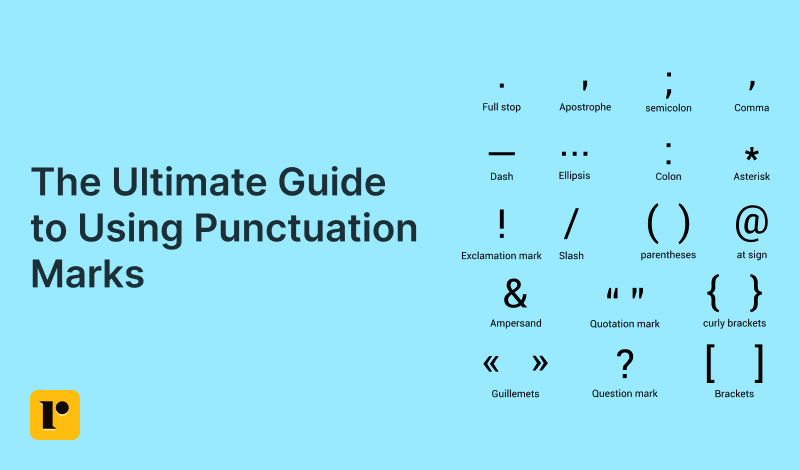
Punctuation is one of the most important parts of writing in any language. It is a silent yet powerful element of grammar. It helps to share or present ideas effectively. These signs add expressions to the writing and make the text look organized.
Correct punctuation marks add clarity and precision to written work. Moreover, these signs allow the writers to stop, pause, or emphasize certain sentences according to the context.
This blog will teach you everything about the important part of linguistics. We will also go through some common questions. So, let’s get started!
Punctuation marks are divided into different categories depending on how they function in a sentence. Here is a breakdown of the main types you will encounter in English writing.
These punctuation marks show the end of a sentence.
These help break up or connect ideas within a sentence.
Used for emphasis or interruption in a sentence.
These highlight direct speech or phrases from another source.
These serve special functions like showing ownership or creating contractions.
Some punctuation marks appear frequently in all forms of writing. Most people know the basics, but many of these marks have multiple uses that often go unnoticed. Everyone should know how to use proper punctuation in paragraphs to ensure clarity and effective communication. Below, we will look at some of the most commonly used punctuation marks with clear examples.
A period, or full stop, marks the end of a sentence or a complete thought. It's most commonly seen in statements and commands.
To end a complete sentence
In abbreviations and initials
For indirect questions
Commas help organize ideas by separating different parts of a sentence. They allow the reader to pause and understand the structure of the sentence more easily.
To join independent clauses with conjunctions
To list items in a series
To set off introductory words or phrases
To separate ideas for clarity
To add afterthoughts or clarify a sentence
To address someone directly
A colon is used to introduce or expand on an idea. It connects two clauses when the second explains or elaborates on the first.
Before a list or explanation
In dialogue or scripts
To highlight or emphasize a point
In titles
A semicolon links closely related ideas that could stand alone as sentences but are better understood when presented together.
To join related independent clauses
To clarify items in a complex list
To connect contrasting ideas
Apostrophes are used for two primary reasons: to show ownership and to form contractions by omitting letters.
To show possession
To create contractions
Quotation marks are used to show the exact words spoken or written by someone. They can also indicate titles and special usage of words.
To enclose direct speech or quotations
To quote text from another source
For titles of short works
To highlight a word used in an unusual or ironic way
A dash (specifically the em dash) is used to create a strong break in a sentence or to insert additional information.
To add emphasis or interruption
To insert extra information or clarification
To replace parentheses for more emphasis
Parentheses enclose extra information that’s helpful but not essential to the main point.
To provide additional details
To clarify abbreviations or acronyms
An ellipsis shows that part of a sentence or quote has been omitted or that the thought is trailing off.
To indicate omitted text
To suggest a pause or an unfinished thought
The exclamation mark shows strong emotion, urgency, or emphasis.
To express strong feelings
In interjections and exclamatory sentences
A question mark is used at the end of a sentence to indicate a direct question.
To end a question
In rhetorical questions
The Oxford comma, also known as the serial comma, is placed before the final item in a list of three or more. The Oxford comma helps avoid confusion. For example:
Without it: I dedicate this book to my parents, Oprah Winfrey and Stedman Graham.
(This sounds like your parents are Oprah and Stedman Graham.)
With it: I dedicate this book to my parents, Oprah Winfrey, and Stedman Graham.
In American English, periods always go inside the quotation marks.
Correct: She said, “Let’s meet at noon.”
Incorrect: She said, “Let’s meet at noon”.
This rule also applies to commas.
When using commas with parentheses (round brackets), the placement depends on where the parentheses appear in the sentence.
If the bracketed text is part of the sentence, the comma comes after the closing bracket.
If the entire sentence is inside parentheses, the period stays inside.
Note: Do not place a comma before an opening bracket.
In American English:
Double quotation marks (“ ”) are used for direct speech and quotations.
Single quotation marks (‘ ’) are used for quotes within a quote.
In British English, this is reversed.
Use the free punctuation checker by rewordingtool.io to correct punctuation mistakes in your writing. This tool analyses the text and finds all kinds of punctuation errors in your writing. Then, it provides accurate suggestions to rectify them. Simply paste your text into the tool, and it will evaluate the writing for improved readability.